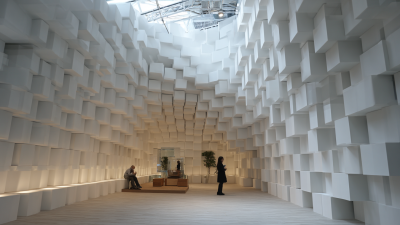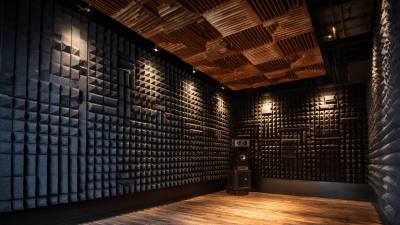In our fast-paced, modern world, the importance of creating healthy and productive environments cannot be overstated. One innovative solution that has emerged is the use of sound reducing panels, which can transform a space by significantly enhancing its acoustic performance by up to 50%.

These panels not only help in reducing noise pollution but also promote better focus, relaxation, and overall well-being.
In this guide, we will explore practical tips and techniques for effectively incorporating sound reducing panels into various settings, whether it's an office, classroom, or home environment.
By understanding the benefits and applications of these panels, you can take meaningful steps towards creating a quieter, healthier space that fosters creativity and comfort.
Join us as we delve into the world of sound reducing panels and discover how they can redefine your surroundings for the better.
In modern urban environments, noise pollution has become an inescapable reality, impacting health and well-being. The implementation of sound reducing panels plays a pivotal role in enhancing acoustic comfort across various spaces. Statistics indicate that effective acoustic solutions can improve sound absorption by up to 50%, significantly reducing echoes and reverberation, which are often the culprits behind a stressful atmosphere. As cities continue to develop, the demand for high-quality acoustic panels is on the rise, driven by a growing awareness of the detrimental effects of persistent noise.

One innovative approach is the integration of sound absorbing elements with aesthetic designs, creating an inviting ambience without compromising on performance. For instance, products that combine soft, diffused lighting with high-performance sound absorption not only provide practical benefits but also elevate the overall design of interior spaces. Moreover, the resurgence of decor trends like DIY acoustic panels showcases a shift towards personalized and effective noise control solutions, promoting a calmer, quieter living environment. As urbanization accelerates, investing in sound reducing panels is becoming increasingly essential for both residential and commercial buildings, ensuring healthier environments for all.
Sound reducing panels have revolutionized the way we address noise pollution in various environments, from office spaces to residential areas. Recent studies indicate that implementing high-quality acoustic panels can improve sound absorption by up to 50%, significantly enhancing the overall acoustics of a space. According to a report by the National Institute of Occupational Safety and Health (NIOSH), excessive noise in workplace settings can lead to lower productivity and increased stress levels, making the need for effective sound reduction solutions more critical than ever.
Key features of sound reducing panels include their material composition, design versatility, and ease of installation. High-density materials, such as mineral wool and fiberglass, are commonly used due to their superior sound-absorbing properties. Furthermore, modern panels come in a variety of aesthetic styles, enabling them to blend seamlessly with existing decor while fulfilling their functional purpose. The American Society of Acoustics highlights that integrating these panels into commercial spaces can reduce reverberation times by over 60%, creating a more comfortable and healthier environment for occupants.

When it comes to enhancing the acoustic quality of any environment, sound reducing panels are a transformative solution. With a remarkable 50% improvement in acoustic performance, these panels not only create a more pleasant atmosphere but also promote healthier spaces by mitigating noise pollution. This is especially important in settings such as offices, schools, and healthcare facilities where clarity and concentration are paramount.
Choosing the right sound panels is crucial for maximizing their effectiveness. First, consider the material of the panels; options like fiberglass or foam can absorb sound differently. Second, evaluate the panel thickness—thicker panels typically offer better sound absorption, especially for lower frequencies. Lastly, pay attention to the design and aesthetics; selecting panels that complement your space can enhance both functionality and visual appeal. By following these tips, you can create an environment that fosters well-being and productivity through improved acoustics.
When considering the installation of sound-reducing panels, it's essential to maximize their acoustic performance to create a healthier and more enjoyable environment. The positioning of these panels plays a crucial role in their effectiveness. Ideally, place them at ear level where sound reflections are most prominent, especially on walls that face hard surfaces. This strategic placement can help in absorbing and minimizing unwanted echoes.
Tips: To further enhance sound absorption, consider using a variety of panel sizes and shapes. This variation can help disrupt sound waves more effectively and provide a more balanced acoustic environment. Additionally, ensure that the panels are securely mounted to prevent any rattling or shifting that may reduce their effectiveness over time.
Another important factor is the room's layout. Assess the furniture arrangement and other elements that could contribute to sound reflection. Incorporating softer furnishings, like rugs and upholstered items, in conjunction with your panels can significantly improve overall sound quality.
Tips: If you need to find the right balance between aesthetics and functionality, choose panels that complement your decor while optimizing acoustic performance. Using colors and textures that match your interior design can ensure that sound reduction becomes an integral part of the space rather than an eyesore.
| Dimension | Description | Acoustic Performance Improvement (%) | Installation Time (Hours) | Cost Estimate ($) |
|---|---|---|---|---|
| Panel Size: 2x4 ft | Ideal for walls and ceilings to reduce echo. | 50% | 2-4 | 150 |
| Panel Thickness: 2 inches | Provides deeper sound absorption, suitable for music rooms. | 55% | 3-5 | 200 |
| Panel Material: Fabric-wrapped | Aesthetic finish with effective sound dampening. | 45% | 1-3 | 120 |
| Panel Color Options | Various colors to match interior design. | 40% | 2-4 | 160 |
Improved acoustics in our living environments can substantially enhance overall health and well-being. According to a study published by the World Health Organization, poor acoustic conditions can lead to various health issues, including stress, fatigue, and cardiovascular diseases. By integrating sound-reducing panels, spaces can achieve up to a 50% improvement in acoustic performance, drastically reducing noise pollution that disrupts concentration and sleep quality.
Incorporating sound-absorbing materials not only fosters a more serene atmosphere but also creates environments conducive to productivity and relaxation. A report from the Acoustical Society of America highlights that better acoustics can enhance cognitive function and emotional well-being. Therefore, investing in sound-reducing solutions can be a critical step in making homes and workplaces healthier.
Tips for creating a quieter environment include strategically placing sound panels in high-traffic areas or spaces prone to echo, like hallways or conference rooms. Additionally, consider using rugs, curtains, and upholstered furniture to complement sound-absorbing panels and enhance their effectiveness. Creating a harmonious acoustic environment can lead to a healthier, happier life.






